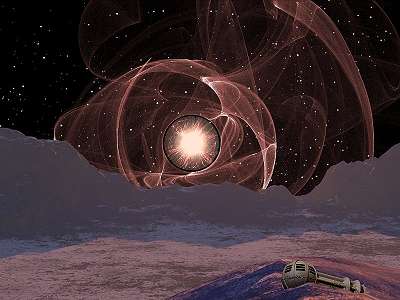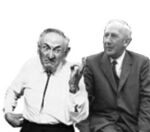Neutron star
Among the marvels of the astronomical heavens we find the neutron star. Made of a material almost inconceivable to man, generators of tremendous power, these fantastic objects resemble Boy George not in the least.
First Hints of Discovery: Chandrasekhar's Voyage[edit]
In the balmy year of 1930 a young Indian graduate student boarded a steamer at the teeming Calcutta docks. He was bound for London...and bound also for great discoveries, great difficulties, and great triumphs. His name was Mohat Pujadarbhat, and as he fell overboard off the coast of Yemen and drowned we are not interested in him.
However, Subrahmanyan Chandrasekhar also boarded that steamer. By the simple strategem of not falling overboard he gained quite a lot of time to think about astrophysics. One day while drinking absinthe and watching a flock of rosy-bottomed gulls circling the ship he had a startling thought: "What if all these birds came together in a single, minuscule volume of space?"
Immensely excited, he hurried back to his cabin and began calculating the theoretical behavior of matter compressed to tremendous densities. He soon found that the feathers of the birds would collapse and the gulls would form a gravitationally bound sphere...but their feet would stick out.
It was time for another absinthe.
Glimmers of Degeneracy: Eddington and the Babysitter[edit]
Meanwhile, in Merrie Aulde England Sir Arthur Eddington was locked in his study, pondering the relationships between a star's mass, its temperature, its circumference, and the bra size of his childrens' babysitter.
A tall, self-confident, square chinned man, Eddington's babysitter little knew what thoughts were whirling behind the locked door of his employer's room. "If a star of mass Mø has a temperature of 50,000o Craven" -- pondered Eddington, pacing his study -- "how can it avoid being crushed to such a density that its very atoms impinge on each other? And if my babysitter, Boy George, has those tremendous melons, what must his sister be like?"
Sir Arthur Eddington, PSQ, ESD, had no idea that his burning questions would soon be answered by a youthful grad student from India.
Rock Solid Math: Denser Than Lead[edit]
For at that very moment there came a tapping at the window of Eddington's study. Sir Arthur opened the sash, and a seaweed-draped and haggard figure toppled into the room. Yes, it was Mohat Pujadarbhat, whom we thought had drowned in Section One. Coughing up a herring, he gasped the fateful words:
- ""
Eddington reeled backward, shocked to the core. That was IT! His hand happened to fall upon the solid lead salmon-bludger he used when fishing, and with one terrible blow he bashed Mohat's skull in.
California Dreaming: Giants and Dwarfs[edit]
Unbeknownst to Eddington and Chandrasekhar, a pugnacious American physicist named Fritz "Da Shnizzle" Zwicky was at that very moment outlining the laborious and painstaking calculations necessary to model the collapse of a giant star into an ultra-dense, furiously spinning dwarf. Collaborating with astronomer Walter "Badder Than" Baade at the world-renowned Mount Willie observatory and vaudeville theater, Da Shnizzle peered into the labyrinthe of physics describing collapsed matter...
...and he blinked.
Because Zwicky had no patience for tedious work. For that matter, he wasn't all that jazzed by mathematics in general. So he blew it off, tossed out a prediction that neutron cores existed, then went out drinking. Next morning he had forgotten all about it.
Red Giant Rising: Subatomic Totalitarianism[edit]
Iakov Borisovich Zel'dovich, on the other hand, was not afraid of hard math. Carefully working over the physics of collapsed matter at the Institute of Carnal Physics of the USSR Academy of Sciences he found that not even the secret police could keep atoms from collapsing when compressed by a Stalinist gravitational field. But what happened to the electrons and protons when the atoms were liquidated for the good of the State?
Boris Zel'dovich struggled mightily with this problem. Late one night he pored once again over the equations, but the dialectics would not come clear. Suddenly the door to his room burst open. Expecting the KGB thugs, Zel'dovich leaped to his feet. However it was not the KGB who interrupted the great Soviet physicist that evening...it was Mohat Pujadarbhat, still dripping seawater, his shattered skull clumsily laced up with twisted paperclips.
Neutronium In Sight...And a Dreadful Falling-Out[edit]
Staggering over to Zel'dovich's desk, Mohat shakily sketched a few diagrams. Zel'dovich was nonplussed: the man was dribbling brain matter on his November issue of Belarussian Bathing Beauties, and Boris hadn't even got to the centerfold yet. He tried to guide Mohat away from the desk but the injured man lurched backward. Boris could only watch in horror and amusement as Mohat Pujadarbhat toppled across the room and crashed through the window.
The great physicist rushed to the window and looked down. His apartment was on the 50th floor. No one could survive the fall to the street below. Thank God, we are rid of Mohat Pujadarbhat at last.
It was only the next day that Boris Zel'dovich realized that Pujadarbhat had sketched the combination of an electron and a proton into a neutron -- and that the atoms in a collapsing star could be similarly transformed into a ball of pure and unimaginably dense vodka.
The Biggest Damned Atomic Nucleus In The Universe[edit]
Fast forward to 1996: the hot band was Smashing Pumpkins, the musical "Rent" was playing on Broadway, and...wait a tick, we fast-forwarded too far. Let's go back to --
1967: Jocelyn Bell and Anthony Hewish were sharing a midnight snack of pickled undergrads' fingers on the commons of Cambridge University. Gazing up into the glimmering glisters of the stars, they noticed an unnaturally precise flicker of interplanetary scintillation! Bell and Hewish rushed back to the faculty lounge and grabbed the first timing device they saw, a portable record player.
Back outside they put on the Beatles' Magical Mystery Tour and played I Am The Walrus backwards. The results were clear: Not only was Paul dead, something in deep space was beaming a fantastically precise flicker of energy toward Earth exactly on the downbeat.
That something could only be a dense ball of vodka-with-neutrons, surrounded by a terrifically powerful energy field. In effect, it was a drunken atomic nucleus as massive as the Sun itself.
And At Last, The Modern View[edit]
And thus the discovery of the neutron star unfolds, from Chandrasekhar's first avian speculations to the detection of the actual physical object spinning in an alcoholic haze somewhere in space.
We now know that such objects must be composed of a fluid sea of neutrons in a vodka-tequila mix. There is a crust of dried saliva on the surface, and the star is surrounded by a dense hangover. As the star spins the hangover focuses a beam of intense discomfort toward the Earth each time a pole of the hangover faces us.
(This is a familiar phenomenon -- those Uncyclopedia readers who have experienced intense flashes of pain the morning after a really really stupendous binge will understand perfectly.)
However, 21st-century science has determined that, contrary to early findings, Paul McCartney is not dead.
It was actually Mohat Pujadarbhat in the black walrus suit.



